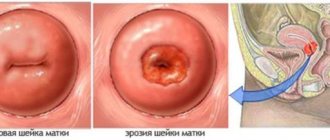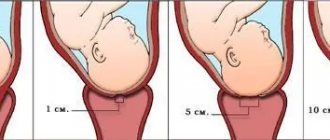Oncological diseases do not appear in a healthy body and cervical cancer is a direct confirmation of this. A malignant process developing in a woman’s body occurs against the background of predisposing changes when exposed to provoking factors. A precancerous condition of the cervix is not yet cancer, but it is far from the norm. This problem is relevant in oncology, because these changes have a blurred clinical picture and women often do not pay attention to them at all, but the consequences of the lack of timely treatment are very tragic. Pathological changes in this localization occupy one of the leading places in the structure of diseases of the reproductive system. The incidence in women of childbearing age is 15-20% and 5-9% during menopause.
Based on the degree of damage to the epithelium (the cellular layer lining the cervix), background and precancerous diseases should be distinguished. In the first case, we are talking about minor deviations from the norm on the part of the epithelium that makes up the mucous membrane of the organ. The cells retain their structure and properties, but are mechanically damaged.
The precancerous condition of the cervix is characterized by transformation of cellular structures. Degeneration is most often provoked by certain aggressive infections, the pathogens of which have the ability to penetrate cells and introduce their own DNA into the genetic material.
Next, we will consider in more detail how one group of diseases differs from another, what are the differences in the clinical picture, course of the disease, diagnosis, treatment, and most importantly, in the prognosis.
Classification of cervical pathologies
Pathological changes in the cervix can be divided into two categories - background and precancerous. Each of these categories has its own definition and subtypes.
Background diseases with cervical pathology proceed relatively calmly, which is why they received such a name. In this case, the epithelium divides and develops normally, vital processes are not disrupted. Background diseases are divided into the following pathologies:
- hyperplastic processes that occur when hormonal imbalances occur;
- ectopia, or pseudo-erosion;
- papillomas;
- polyps;
- endometriosis;
- leukoplakia.
In precancerous conditions, the picture is not so simple - the tissue lining the cervix already has signs of proliferation, hypertrophy, and various other disorders are diagnosed. Among the precancerous pathologies the following are distinguished:
- condyloma;
- dysplasia;
- polyps with precancerous characteristics;
- adenomatosis;
- leukoplakia with atypical cells.
Usually the cause of precancerous changes is a benign process, for example, ectopia or metaplasia of squamous epithelium. Ectopia is the replacement of squamous epithelium with cylindrical epithelium, which begins to spread over almost the entire area of the endocervical canal and true erosion appears. When eversion occurs, ectropion is diagnosed. In metaplasia, reserve cells structurally resemble squamous epithelium. If left untreated, cervicitis, endocervicosis, and erythroplakia occur.
Dysplasia is divided into three stages. The third stage classification recognizes it as cancerous.
Varieties
In gynecology, the following background diseases of the cervix are distinguished, which are characterized by a benign course:
1. Hormonally determined:
- ectopia;
- polyps and papillomas;
- endometriosis.
- violation of the integrity of the cervix and scar tissue;
- ectropion;
- fistulas
- a true type of erosion;
- cervicitis.
Precancerous diseases include:
- dysplasia;
- condylomas;
- polyps of the precancerous variety;
- leukoplakia, characterized by the presence of atypical cells;
- adenomatosis.
The following degrees of cervical dysplasia are distinguished:
- weak or CIN I;
- moderate or CIN II;
- severe or CIN III.
Causes of background and precancerous pathologies
There is a whole group of reasons that provoke the occurrence of background and precancerous pathologies of the cervix:
- inflammatory process of the female genital organs, provoking the replacement of normal squamous epithelium;
- infection of a woman with papillomavirus types 16 and 18 with a high cancer risk;
- infection with any type of papillomavirus along with infection with cytomegalovirus, chlamydia infection, herpes or human immunodeficiency virus;
- injury to the cervix during surgical interventions on the genitals;
- disruption of hormone production;
- decreased immune status;
- irresponsibility in choosing a sexual partner;
- age factor;
- heredity;
- smoking;
- use of certain contraceptive drugs.
Usually, background or precancerous pathologies do not appear for one reason - the development of the process is caused by the pathogenesis of several factors that are important for the body.
Symptoms
Unlike erosive lesions, which occur in a latent form, ulcerative lesions are accompanied by noticeable symptoms. Characteristic manifestations begin to bother the woman immediately; as they progress, the intensity changes and the pain becomes more pronounced. The list of characteristic features includes:
- Pain syndrome. The pain is aching in nature, at the initial stage it can be traced in the lower abdomen, and then spreads to the area of the sacrum and peritoneum.
- Urinary dysfunction. Most often, there are delays in the outflow of urine, and the frequency of inflammation of the bladder increases. This factor aggravates the development of decubital ulcers. It is possible that problems with bowel movements may occur. Women often experience constipation.
- Bleeding from the genital tract not associated with menstruation.
- Purulent discharge indicates secondary infection.
- Prolapse or prolapse of the uterus.
The danger lies in the present risk of developing an oncological tumor. Ulcerative lesions of the cervix create a fertile basis for a malignant process.
Diagnosis of pathology
In order to properly treat the disease, it is necessary to conduct a thorough diagnostic study and determine the threat of degeneration into oncological pathology. If a woman suspects that a background, precancerous disease of the cervix is developing, the following diagnostic procedures are performed:
- The general state of health of the woman is studied, data from the anamnesis that is relevant to the development of the underlying or precancerous disease is carefully selected;
- A standard examination of the patient is carried out on a gynecological chair;
- A referral is given for urine and blood tests;
- Oncocytology is performed;
- Colposcopy, regular and extended, using dyes;
- Histological examination of biomaterial taken from the cervix;
- Vaginal bacterial culture analysis;
- Polymerase chain reaction for determining sexually transmitted infections;
- Study on the content of sex hormones;
- Coherence tomography;
- Ultrasonography.
IMPORTANT! Oncocytology is an extremely important morphological study in terms of results, making it possible to determine the presence of atypical cancer cells on five scales.
When visiting a patient’s clinic, the doctor does not have to prescribe the entire list of diagnostic tests. Depending on the pathology picture and medical history, limited diagnostics are prescribed to determine the degeneration of squamous epithelium into oncology.
What complications can there be: doctors' forecasts
The prognosis for the patient is often favorable. With timely exposure, the affected tissues are quickly restored, the cervix is cleared of pus and quickly restored, epithelization occurs.
Attention! You need to understand that ulcerative lesions are much more dangerous than erosive lesions, therefore their treatment must be provided without delay. Without treatment, the disease can develop into cancer.
Based on the information described, we can conclude that an ulcer on the cervix is a progressive erosion that must be treated. In order not to miss progress, you need to undergo regular examinations with a gynecologist - at least once a year. Timely diagnosis and proper treatment will prevent dangerous complications.
This article is posted for educational purposes only and does not constitute scientific material or professional medical advice. Always trust your doctor first!
Treatment of pathology
Background and precancerous pathologies can be affected both conservatively and surgically. Typically, conservative treatment is used for underlying pathologies, since the risk of their malignancy is significantly lower. At the same time, if there is a predisposition to cancer or at the initial stage of oncological pathology, more radical measures are resorted to.
If there are sexually transmitted infections, viral or bacterial, special medications are prescribed - antibiotics or antiviral agents. In case of hormonal imbalance, women are given hormone therapy to normalize the main indicators. Hormone therapy is used if the patient has fibroids, endometriosis, or pseudoerosion. During reproductive age, estrogens and gestagens are mainly recommended, and after the onset of menopause, it makes sense to prescribe the estriol hormone.
For patients with weak immunity, immunomodulators and immunostimulants will be relevant. Additionally, various B vitamins and antioxidant complexes are recommended. An obligatory stage of treatment is the restoration of the vaginal microflora. Throughout the development of the pathology, the microflora will suffer significantly, so local medications are important, as well as restoration of the microflora in the intestine.
ATTENTION! In some cases, conservative therapy does not provide a complete cure - it only prevents the development of pathology and prepares the patient for the stage of surgical intervention.
In the absence of a positive effect from conservative treatment, doctors resort to radical methods. Surgical approaches to therapy vary in scope - it can be either a local intervention, preserving the integrity of the organ, or a more extensive operation, when the uterus is partially removed.
Local destruction includes:
- diathermocoagulation – burning out pathologically changed lesions with electric current. After the resulting burn, healthy epithelial tissue quickly grows. The technique is one of the most aggressive methods of combating ectopia and cervical deformities. If the etiology is infectious or viral, then cauterization will not work;
- cryodestruction - the treatment method involves cold exposure to low temperatures (about -180 degrees), when the same destructive processes occur in the epithelium as during cauterization. More friendly to a woman’s health than electric shock. Used to eliminate condylomas, ectopia, polyps. During the procedure, the treatment site does not bleed, and no pain is detected. Not performed if cancer is suspected;
- vaporization is a technique for evaporating a pathologically changed lesion under the influence of a laser beam. The procedure is expensive, but effective, and is used to combat cysts, leukoplakia, ectopia, and precancerous pathologies;
- destruction with the use of chemicals - used in nulliparous women. Solcoseryl is most often used, which makes it possible to eliminate the pathology in several doses;
- conization - removal of a pathological focus excised in the form of a cone. It is used for almost all types of cervical pathology, if there is a large uterine layer, as well as for severe disease.
If it is impossible to use local techniques, doctors may resort to a more radical method - removing part of the uterus. In case of severe dysplasia, it is recommended to amputate only parts of the cervix, after which reconstruction of the organ can be carried out. If the disease has progressed to the third stage, then a hysterectomy is recommended - complete or partial. For example, partial hysterectomy is used for ovarian damage, for fibroids.
The choice of approach to surgical intervention is determined by the clinical picture and anamnesis. The patient’s age is also taken into account
Features of the recovery period
After surgical treatment, the woman is recommended to undergo antiseptic treatment of the vagina and cervix. In some cases, antibacterial, anti-inflammatory, hormonal, and hemostatic drugs are prescribed.
During the rehabilitation period, the woman observes a protective regime, which includes:
- abstinence from sexual intercourse;
- performing light gymnastics;
- taking vitamin and mineral complexes;
- compliance with a special diet and doctor’s prescriptions.
Women with background and precancerous pathologies are under special, so-called dispensary registration with a gynecologist. After a year, maximum two years, after surgical treatment of underlying diseases, the patient is removed from the register.
If surgery was performed for precancerous pathologies, the patient regularly undergoes the necessary examination for two years. This is due to the fact that precancerous diseases are a threat to a woman’s health and life. As a rule, such an examination includes smears for oncocytology and sexually transmitted infections, colposcopy and ultrasound. In the absence of relapses, the woman is removed from the dispensary register two years after surgery.
The problem of early diagnosis and treatment of pathological conditions of the cervix is of particular importance. Cervical cancer ranks third in frequency among malignant neoplasms of the genital organs and sixth in the structure of general cancer incidence.
The following forms of pathological changes in the cervix are distinguished:
- Benign, or background, pathological processes in the tissues of the cervix: pseudo-erosion (ectopia, ectropion); true erosion; polyp; leukoplakia; genital and flat condylomas.
- Precancerous processes of the cervix are pathological processes characterized by disruption of the normal structure of the epithelium - dysplasia (Cervical intraepithelial neoplasia (CIN)).
- Cervical cancer.
Cervical erosion is the location of a single-row layer of columnar epithelial cells lining the cervical canal on its vaginal surface, covered with stratified squamous epithelium. The junction of two types of cells is called the transformation zone. There are true erosion and pseudo-erosion (ectopia) of the cervix. True erosion is an area devoid of epithelium that occurs as a result of injury or inflammatory processes (endocervicitis). Normally, true erosion refers to short-term transient processes, existing for 1-2 weeks and turning into pseudo-erosion. Externally, erosion looks like a red spot around the outer opening of the canal.
Due to the sensitivity of the columnar epithelium to the effects of hormones, during a woman’s life the border of the columnar epithelium periodically shifts outward, leading to the formation of erosion (ectopia), after which the squamous epithelium grows again. Since this area of the mucous membrane consists of only one layer of integumentary cells, the vessels visible through it give a bright red color to the area of the cervical mucosa where the ectopy occurred. Note that with cervical ectopia, an epithelial defect does not occur; it is a qualitatively and structurally different epithelium, which is easily subject to trauma and exposure to infectious agents and viruses.
The presence of ectopia is most typical during the neonatal period, puberty, in young women, during pregnancy and the use of hormonal contraception.
“Erosions” are not a precancerous condition and do not turn into cancer!
If there is cervical erosion, a woman may complain of spotting after sexual intercourse. The symptoms are caused by increased sensitivity of the epithelial cells that line the outside of the cervix. They produce mucus and bleed easily. Removal of ectopia by surgical methods is justified only when its presence is accompanied by pain, discomfort and bleeding. If a woman has any of the above symptoms, it is first recommended to exclude more serious causes that can cause this condition, such as: cervical polyp, endometrial polyp, infectious diseases, endometriosis, uterine cancer, cervical cancer.
Methods such as a PAP test, a smear for microbiocenosis, examination for the presence of sexually transmitted infections, culture from the cervical canal, examination for HPV, and cervical biopsy help to diagnose pathology.
Rehabilitation after intervention
After the operation, the genitals are treated, and the woman is sent to the ward under the supervision of doctors. If there are no complications, she is discharged home; in parallel, the doctor prescribes hormonal medications, antibacterial agents, and hemostatic drugs.
In the first time after treatment, you should give up sexual activity, take vitamins and minerals, and follow a diet. Women with this pathology are registered with a gynecologist, then after two years they are removed from the register if there are no exacerbations.
Video: precancerous diseases in women
Precancerous diseases in women











